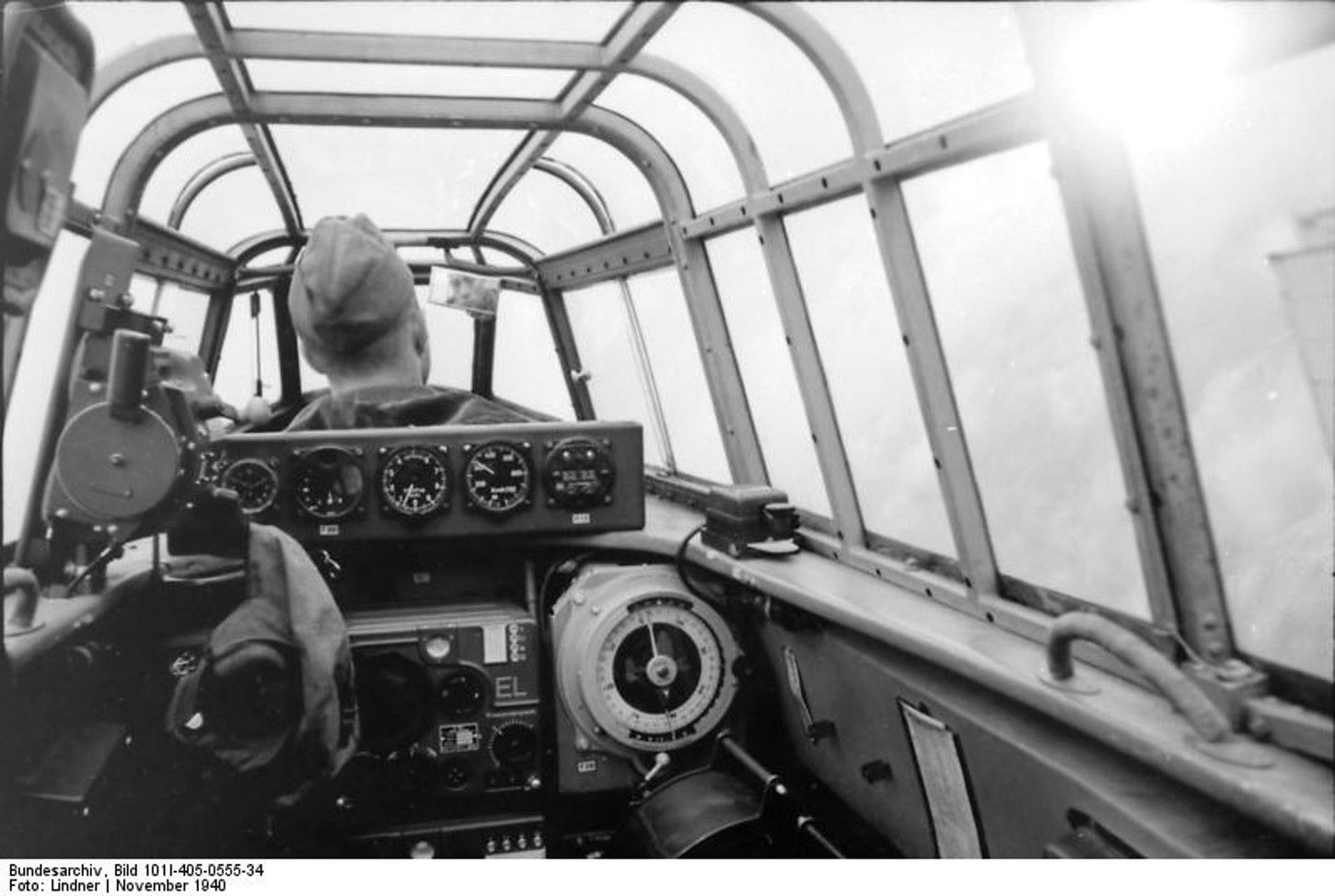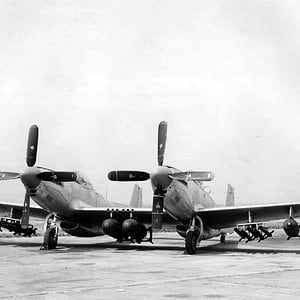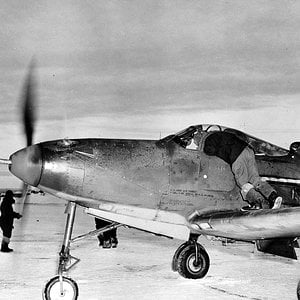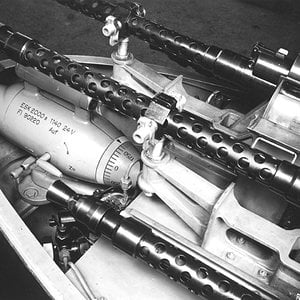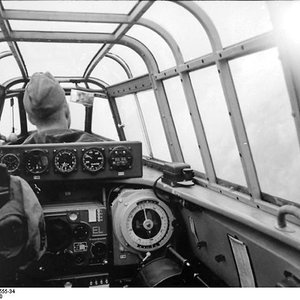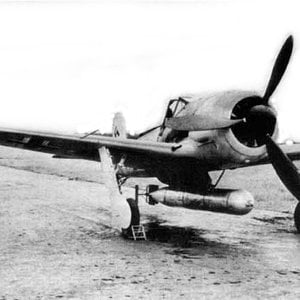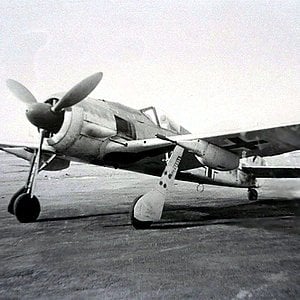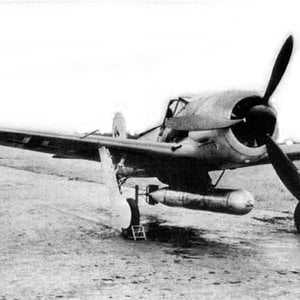Navigation
Install the app
How to install the app on iOS
Follow along with the video below to see how to install our site as a web app on your home screen.
Note: This feature may not be available in some browsers.
More options
You are using an out of date browser. It may not display this or other websites correctly.
You should upgrade or use an alternative browser.
You should upgrade or use an alternative browser.
Later production variantsThe production of the Bf 110 was put on a low priority in 1941 in expectation of its replacement by the Me 210. During this time, two versions of the Bf 110 were developed, the E and F models. The E was designed as a fighter bomber (Zerstörer Jabo), able to carry four 50 kg (110 lb) ETC-50 racks under the wing, along with the centerline bomb rack. The first E, the Bf 110 E-1 was originally powered by the DB 601B engine, but shifted to the DB 601P as they became available in quantity. A total of 856 Bf 110E models were built between August 1940 and January 1942.[9] The E models also had upgraded armour and some fuselage upgrades to support the added weight. Most pilots of the Bf 110E considered the aircraft slow and unresponsive, one former Bf 110 pilot commenting the E was "rigged and a total dog."
The Bf 110F featured the new DB 601F engines which produced 993 kW/1,350 PS (almost double the power the original Jumo engines provided), which allowed for upgraded armour, strengthening, and increased weight with no loss in performance. Three common versions of the F model existed. Pilots typically felt the Bf 110F to be the best of the 110 line, being fully aerobatic and in some respects smoother to fly than the Bf 109, though not as fast. Eventually 512 Bf 110F models were completed between December 1941 and December 1942, when production gave way to the Bf 110G.[9]
Although the Me 210 entered service in mid-1941, it was eventually withdrawn for further development. There were insufficient aircraft to fully replace the Bf 110, so it remained in service until the end of the war. In the wake of the failure of the Me 210, the Bf 110G was designed.[10] Fitted with the DB 605B engines, producing 1,085 kW (1,475 PS) in "War Emergency" setting, and 997 kW (1,355 PS) at 5.8 km (19,000 ft) altitude, the Bf 110G also underwent some changes which improved the aerodynamics of the aircraft, as well as upgrading the nose armament. No Bf 110 G-1 existed, as the Bf 110 G-2 became the baseline Bf 110G and was fitted with a large number of Rüstsätze, making the G the most versatile of the Bf 110. The initial batch of six pre-series production G-0 aircraft built in June 1942 followed by 797 G-2, 172 G-3 and 2,293 G-4 models, built between December 1942 and April 1945.[9] Pilots reported the Bf 110G to be a "mixed bag" in the air, in part due to all changes between the G and F series. However the Bf 110G was considered a superior gun platform with excellent all-around visibility, and considered, until the advent of the Heinkel He 219, the best of the Luftwaffe night fighters.
[edit] ArmamentThe Bf 110's main strength was its ability to accept some extreme weaponry. Early versions had four 7.92 mm (.312 in) MG 17 machine guns in the upper nose and two 20 mm MG FF/M cannons fitted in the lower part of the nose. Later versions replaced the MG FF/M with the more powerful 20 mm MG 151/20 cannons and many G-series aircraft, especially those who served in the bomber-destroyer role, had two 30 mm (1.18 in) MK 108 cannons fitted instead of the MG 17. The defensive armament consisted of a single, flexibly-mounted 7.92 mm (.312 in) MG 15 machine gun. Late F-series and prototype G-series were upgraded to a 7.92 mm (.312 in) MG 81 machine gun with a higher rate of fire and the G-series was equipped with the twin-barrelled MG 81Z. Many G-series night fighters were retrofitted or factory-built with the Schräge Musik (Jazz Music) off-bore gun system, firing upward at an oblique angle for shooting down bombers while passing underneath, frequently equipped with two 20 mm MG FF/M, but field installations of the 20 mm MG 151/20 or 30 mm (1.18 in) MK 108 cannons were also utilized. The Schräge Musik weapons were typically mounted to the back of the rear cockpit.
The Bf 110 G-2/R1 was also capable of accepting armament such as the Bordkanone series 37 mm (1.46 in) BK 37 cannon. A single hit from this weapon was enough to destroy any Allied bomber.
The fighter-bomber versions could carry up to 2,000 kg (4,410 lb) of bombs, depending on the type.
[edit] Operational serviceMain article: Messerschmitt Bf 110 operational history
[edit] VariantsBf 110 A
Prototypes with two Junkers Jumo 210 engines.
Bf 110 A-0
The designation of the first four pre-production aircraft.
Bf 110 B
Small scale production with two Jumo 210 engines.
Bf 110 B-0
First pre-production aircraft, similar to B-1.
Bf 110 B-1
Zerstörer, four 7.92 mm (.312 in) MG 17 machine guns and two 20 mm MG FF cannons, nose-mounted.
Bf 110 B-2
Reconnaissance, both MG FF cannons removed, and various camera models added.
Bf 110 B-3
Trainer. MG FF cannons removed, and extra radio gear added. Some war weary B-1 were later refitted as B-3s.
Bf 110 C
A captured Bf 110C-4 in the service of the Royal Air ForceFirst major production series, DB 601 engines.
Bf 110 C-0
Ten pre-production aircraft.
Bf 110 C-1
Zerstörer, DB 601 B-1 engines.
Bf 110 C-2
Zerstörer, fitted with FuG 10 radio, upgraded from FuG III.
Bf 110 C-3
Zerstörer, upgraded 20 mm MG FFs to MG FF/M.
Bf 110 C-4
Zerstörer, upgraded crew armor.
Bf 110 C-4/B
Fighter-bomber based on C-4, fitted with a pair of 250 kg (550 lb) ETC 250 bomb racks and upgraded DB 601 Ba engines.
Bf 110 C-5
Reconnaissance version based on C-4, both MG FF removed, and Rb 50/30 camera installed, uprated DB 601P engines.
Bf 110 C-6
Experimental Zerstörer, additional single 30 mm (1.18 in) MK 101 cannon in underfuselage mount, DB 601P engines.
Bf 110 C-7
Fighter-bomber based on C-4/B, two ETC-500 centerline bomb racks capable of carrying two 500 kg (1,100 lb) bombs, uprated DB 601P engines.
Bf 110 D
Heavy fighter/fighter-bomber, extreme range versions based on C-series, often stationed in Norway.
Bf 110 D-0
Prototype utilizing C-3 airframes modified with 1,200 L (320 US gal) belly-mounted tank called Dackelbauch.
Bf 110 D-1
Long-range Zerstörer, modified C series airframes with Dackelbauch belly tank.
Bf 110 D-1/R2
Long-range Zerstörer, removed Dackelbauch tanks and replaced with wing mounted 900 L (240 US gal) drop tanks.
Bf 110 D-2
Long-range Zerstörer, two wing-mounted 300 L (80 US gal) drop tanks and centerline mounted 500 kg (1,100 lb) ETC 500 bomb rack.
Bf 110 D-3
Long-range Zerstörer, lengthened tail for rescue dingy. Either two wing-mounted 300 L (80 US gal) or 900 L (240 US gal) drop tanks could be fitted. 500 kg (1,100 lb) ETC 500 was optional.
Bf 110 E
Bf 110 E-1, Zerstörer-Ergänzungsgruppe, Deblin-Irena (Poland 1942).Mostly fighter bombers, strengthened airframe, up to 1,200 kg (2,650 lb) bombload.
Bf 110 E-0
Pre-production version, Daimler-Benz DB 601B engines, pair of ETC50 bomb racks fitted outboard of engines, armament as C-4.
Bf 110 E-1
Production version of E-0, DB 601P engines.
Bf 110 E-2
DB 601P engines, rear fuselage extension same as for D-3.
Bf 110 E-3
Long-range reconnaissance version.
Bf 110 F
Same as the E, again strengthened airframe, better armor, two 993 kW (1,350 PS) DB 601F engines.
Bf 110 F-1
Fighter-bomber.
Bf 110 F-2
Long-range Zerstörer, often used against Allied heavy bombers.
Bf 110 F-3
Long-range reconnaissance version.
Bf 110 F-4
The first real night fighter (specially designed for this usage, 3-crew).
Bf 110 G
Bf 110 G-4
A Bf 110 G-4 night fighter at the RAF Museum in London.Improved F-series, two 1,085 kW (1,475 PS) DB 605B engines, tail rudders increased in size.
Bf 110 G-1
Not built.
Bf 110 G-2
Fighter-bomber, fast bomber, destroyer, often used against Allied heavy bombers. (often equipped with rockets).
Bf 110 G-3
Long-range reconnaissance version.
Bf 110 G-4
Three-crew night fighter, FuG 202/220 Lichtenstein radar, optional Schräge Musik, usually mounted midway down the cockpit with the cannon muzzles barely protruding above the canopy glazing.
Bf 110 H
The final version, similar to the G, prototype/design stage only, cancelled.
[edit] Operators Germany
Luftwaffe
Hungary
Royal Hungarian Air Force
Italy
Regia Aeronautica
Romania
Royal Romanian Air Force
Soviet Union
Soviet Air Force operated a few captured Bf 110s.[11]
Croatia
Air Force of the Independent State of Croatia
[edit] Survivors
Bf 110 is on display in the Deutsches Technikmuseum BerlinThree intact Bf 110s are known to exist, although one of them is rebuilt from rescued parts from several different airframes. One, a Bf 110 G-4 night fighter that had been surrendered to the allies in May 1945 at Grove airfield in Denmark, is displayed at RAF Museum London at Hendon in North London, United Kingdom. Another Bf 110 is on display in the Deutsches Technikmuseum Berlin. A third is displayed in a private museum northwest of Helsingoer, Denmark.
The largely intact fuselage of a Bf 110 (type unknown) is on display in the lower station of the Cairngorm Mountain Railway, Scotland.
[edit] Specifications (Messerschmitt Bf 110 C-4)Data from[citation needed]
General characteristics
Crew: 2 (3 for night fighter variants)
Length: 12.3 m (40 ft 6 in)
Wingspan: 16.3 m (53 ft 4 in)
Height: 3.3 m (10 ft 9 in)
Wing area: 38.8 m² (414 ft²)
Empty weight: 4,500 kg (9,921 lb)
Loaded weight: 6,700 kg (14,771 lb)
Powerplant: 2× Daimler-Benz DB 601B-1 liquid-cooled inverted V-12, 809 kW (1,085 hp)1,100 PS each
Performance
Maximum speed: 560 km/h (348 mph)
Range: 2,410 km (1,500 mi)
Ferry range: 2,800 km (1,750 mi)
Service ceiling: 10,500 m (35,000 ft)
Wing loading: 173 kg/m² (35.7 lb/ft²)
Power/mass: 0.3644 kW/kg (0.155 hp/lb)
Armament
Guns:
2 × 20 mm MG FF/M cannons (180 rpg - 3 drums with 60 rpg, cannon were reloaded by rear gunner or radio operator during flight)
4 × 7.92 mm (.312 in) MG 17 machine guns (1,000 rpg)
1 × 7.92 mm (.312 in) MG 15 machine guns for defense
[edit] Specifications (Messerschmitt Bf 110 G-2)Data from from Messerschmitt BF 110/Me 210/Me 410: An Illustrated History
General characteristics
Crew: 2 (3 for night fighter variants)
Length: 12.3 m (40 ft 6 in)
Wingspan: 16.3 m (53 ft 4 in)
Height: 3.3 m (10 ft 9 in)
Wing area: 38.8 m² (414 ft²)
Loaded weight: 7,790 kg (17,158 lb)
Powerplant: 2× Daimler-Benz DB 605B liquid-cooled inverted V-12, 1,085 kW (1,455 HP)1,475 PS each
Performance
Maximum speed: 595 km/h (370 mph)
Range: 900 km (558 mi) ; 1,300 km (807 mi) with droptanks
Service ceiling: 11,000 m (36,000 ft)
Rate of climb: 8 min to 6,000 m (20,000 ft)
Wing loading: max. 243 kg/m² ()
Armament
Guns:
2 × 20 mm MG 151 cannons 750 rounds: 350 rpg + 400 rpg rounds
4 × 7.92 mm (.312 in) MG 17 machine guns with 1,000 rounds per gun
1 × 7.92 mm (.312 in) MG 81Z twin machine gun installation in rear cockpit, with 850 rounds per gun
The Bf 110F featured the new DB 601F engines which produced 993 kW/1,350 PS (almost double the power the original Jumo engines provided), which allowed for upgraded armour, strengthening, and increased weight with no loss in performance. Three common versions of the F model existed. Pilots typically felt the Bf 110F to be the best of the 110 line, being fully aerobatic and in some respects smoother to fly than the Bf 109, though not as fast. Eventually 512 Bf 110F models were completed between December 1941 and December 1942, when production gave way to the Bf 110G.[9]
Although the Me 210 entered service in mid-1941, it was eventually withdrawn for further development. There were insufficient aircraft to fully replace the Bf 110, so it remained in service until the end of the war. In the wake of the failure of the Me 210, the Bf 110G was designed.[10] Fitted with the DB 605B engines, producing 1,085 kW (1,475 PS) in "War Emergency" setting, and 997 kW (1,355 PS) at 5.8 km (19,000 ft) altitude, the Bf 110G also underwent some changes which improved the aerodynamics of the aircraft, as well as upgrading the nose armament. No Bf 110 G-1 existed, as the Bf 110 G-2 became the baseline Bf 110G and was fitted with a large number of Rüstsätze, making the G the most versatile of the Bf 110. The initial batch of six pre-series production G-0 aircraft built in June 1942 followed by 797 G-2, 172 G-3 and 2,293 G-4 models, built between December 1942 and April 1945.[9] Pilots reported the Bf 110G to be a "mixed bag" in the air, in part due to all changes between the G and F series. However the Bf 110G was considered a superior gun platform with excellent all-around visibility, and considered, until the advent of the Heinkel He 219, the best of the Luftwaffe night fighters.
[edit] ArmamentThe Bf 110's main strength was its ability to accept some extreme weaponry. Early versions had four 7.92 mm (.312 in) MG 17 machine guns in the upper nose and two 20 mm MG FF/M cannons fitted in the lower part of the nose. Later versions replaced the MG FF/M with the more powerful 20 mm MG 151/20 cannons and many G-series aircraft, especially those who served in the bomber-destroyer role, had two 30 mm (1.18 in) MK 108 cannons fitted instead of the MG 17. The defensive armament consisted of a single, flexibly-mounted 7.92 mm (.312 in) MG 15 machine gun. Late F-series and prototype G-series were upgraded to a 7.92 mm (.312 in) MG 81 machine gun with a higher rate of fire and the G-series was equipped with the twin-barrelled MG 81Z. Many G-series night fighters were retrofitted or factory-built with the Schräge Musik (Jazz Music) off-bore gun system, firing upward at an oblique angle for shooting down bombers while passing underneath, frequently equipped with two 20 mm MG FF/M, but field installations of the 20 mm MG 151/20 or 30 mm (1.18 in) MK 108 cannons were also utilized. The Schräge Musik weapons were typically mounted to the back of the rear cockpit.
The Bf 110 G-2/R1 was also capable of accepting armament such as the Bordkanone series 37 mm (1.46 in) BK 37 cannon. A single hit from this weapon was enough to destroy any Allied bomber.
The fighter-bomber versions could carry up to 2,000 kg (4,410 lb) of bombs, depending on the type.
[edit] Operational serviceMain article: Messerschmitt Bf 110 operational history
[edit] VariantsBf 110 A
Prototypes with two Junkers Jumo 210 engines.
Bf 110 A-0
The designation of the first four pre-production aircraft.
Bf 110 B
Small scale production with two Jumo 210 engines.
Bf 110 B-0
First pre-production aircraft, similar to B-1.
Bf 110 B-1
Zerstörer, four 7.92 mm (.312 in) MG 17 machine guns and two 20 mm MG FF cannons, nose-mounted.
Bf 110 B-2
Reconnaissance, both MG FF cannons removed, and various camera models added.
Bf 110 B-3
Trainer. MG FF cannons removed, and extra radio gear added. Some war weary B-1 were later refitted as B-3s.
Bf 110 C
A captured Bf 110C-4 in the service of the Royal Air ForceFirst major production series, DB 601 engines.
Bf 110 C-0
Ten pre-production aircraft.
Bf 110 C-1
Zerstörer, DB 601 B-1 engines.
Bf 110 C-2
Zerstörer, fitted with FuG 10 radio, upgraded from FuG III.
Bf 110 C-3
Zerstörer, upgraded 20 mm MG FFs to MG FF/M.
Bf 110 C-4
Zerstörer, upgraded crew armor.
Bf 110 C-4/B
Fighter-bomber based on C-4, fitted with a pair of 250 kg (550 lb) ETC 250 bomb racks and upgraded DB 601 Ba engines.
Bf 110 C-5
Reconnaissance version based on C-4, both MG FF removed, and Rb 50/30 camera installed, uprated DB 601P engines.
Bf 110 C-6
Experimental Zerstörer, additional single 30 mm (1.18 in) MK 101 cannon in underfuselage mount, DB 601P engines.
Bf 110 C-7
Fighter-bomber based on C-4/B, two ETC-500 centerline bomb racks capable of carrying two 500 kg (1,100 lb) bombs, uprated DB 601P engines.
Bf 110 D
Heavy fighter/fighter-bomber, extreme range versions based on C-series, often stationed in Norway.
Bf 110 D-0
Prototype utilizing C-3 airframes modified with 1,200 L (320 US gal) belly-mounted tank called Dackelbauch.
Bf 110 D-1
Long-range Zerstörer, modified C series airframes with Dackelbauch belly tank.
Bf 110 D-1/R2
Long-range Zerstörer, removed Dackelbauch tanks and replaced with wing mounted 900 L (240 US gal) drop tanks.
Bf 110 D-2
Long-range Zerstörer, two wing-mounted 300 L (80 US gal) drop tanks and centerline mounted 500 kg (1,100 lb) ETC 500 bomb rack.
Bf 110 D-3
Long-range Zerstörer, lengthened tail for rescue dingy. Either two wing-mounted 300 L (80 US gal) or 900 L (240 US gal) drop tanks could be fitted. 500 kg (1,100 lb) ETC 500 was optional.
Bf 110 E
Bf 110 E-1, Zerstörer-Ergänzungsgruppe, Deblin-Irena (Poland 1942).Mostly fighter bombers, strengthened airframe, up to 1,200 kg (2,650 lb) bombload.
Bf 110 E-0
Pre-production version, Daimler-Benz DB 601B engines, pair of ETC50 bomb racks fitted outboard of engines, armament as C-4.
Bf 110 E-1
Production version of E-0, DB 601P engines.
Bf 110 E-2
DB 601P engines, rear fuselage extension same as for D-3.
Bf 110 E-3
Long-range reconnaissance version.
Bf 110 F
Same as the E, again strengthened airframe, better armor, two 993 kW (1,350 PS) DB 601F engines.
Bf 110 F-1
Fighter-bomber.
Bf 110 F-2
Long-range Zerstörer, often used against Allied heavy bombers.
Bf 110 F-3
Long-range reconnaissance version.
Bf 110 F-4
The first real night fighter (specially designed for this usage, 3-crew).
Bf 110 G
Bf 110 G-4
A Bf 110 G-4 night fighter at the RAF Museum in London.Improved F-series, two 1,085 kW (1,475 PS) DB 605B engines, tail rudders increased in size.
Bf 110 G-1
Not built.
Bf 110 G-2
Fighter-bomber, fast bomber, destroyer, often used against Allied heavy bombers. (often equipped with rockets).
Bf 110 G-3
Long-range reconnaissance version.
Bf 110 G-4
Three-crew night fighter, FuG 202/220 Lichtenstein radar, optional Schräge Musik, usually mounted midway down the cockpit with the cannon muzzles barely protruding above the canopy glazing.
Bf 110 H
The final version, similar to the G, prototype/design stage only, cancelled.
[edit] Operators Germany
Luftwaffe
Hungary
Royal Hungarian Air Force
Italy
Regia Aeronautica
Romania
Royal Romanian Air Force
Soviet Union
Soviet Air Force operated a few captured Bf 110s.[11]
Croatia
Air Force of the Independent State of Croatia
[edit] Survivors
Bf 110 is on display in the Deutsches Technikmuseum BerlinThree intact Bf 110s are known to exist, although one of them is rebuilt from rescued parts from several different airframes. One, a Bf 110 G-4 night fighter that had been surrendered to the allies in May 1945 at Grove airfield in Denmark, is displayed at RAF Museum London at Hendon in North London, United Kingdom. Another Bf 110 is on display in the Deutsches Technikmuseum Berlin. A third is displayed in a private museum northwest of Helsingoer, Denmark.
The largely intact fuselage of a Bf 110 (type unknown) is on display in the lower station of the Cairngorm Mountain Railway, Scotland.
[edit] Specifications (Messerschmitt Bf 110 C-4)Data from[citation needed]
General characteristics
Crew: 2 (3 for night fighter variants)
Length: 12.3 m (40 ft 6 in)
Wingspan: 16.3 m (53 ft 4 in)
Height: 3.3 m (10 ft 9 in)
Wing area: 38.8 m² (414 ft²)
Empty weight: 4,500 kg (9,921 lb)
Loaded weight: 6,700 kg (14,771 lb)
Powerplant: 2× Daimler-Benz DB 601B-1 liquid-cooled inverted V-12, 809 kW (1,085 hp)1,100 PS each
Performance
Maximum speed: 560 km/h (348 mph)
Range: 2,410 km (1,500 mi)
Ferry range: 2,800 km (1,750 mi)
Service ceiling: 10,500 m (35,000 ft)
Wing loading: 173 kg/m² (35.7 lb/ft²)
Power/mass: 0.3644 kW/kg (0.155 hp/lb)
Armament
Guns:
2 × 20 mm MG FF/M cannons (180 rpg - 3 drums with 60 rpg, cannon were reloaded by rear gunner or radio operator during flight)
4 × 7.92 mm (.312 in) MG 17 machine guns (1,000 rpg)
1 × 7.92 mm (.312 in) MG 15 machine guns for defense
[edit] Specifications (Messerschmitt Bf 110 G-2)Data from from Messerschmitt BF 110/Me 210/Me 410: An Illustrated History
General characteristics
Crew: 2 (3 for night fighter variants)
Length: 12.3 m (40 ft 6 in)
Wingspan: 16.3 m (53 ft 4 in)
Height: 3.3 m (10 ft 9 in)
Wing area: 38.8 m² (414 ft²)
Loaded weight: 7,790 kg (17,158 lb)
Powerplant: 2× Daimler-Benz DB 605B liquid-cooled inverted V-12, 1,085 kW (1,455 HP)1,475 PS each
Performance
Maximum speed: 595 km/h (370 mph)
Range: 900 km (558 mi) ; 1,300 km (807 mi) with droptanks
Service ceiling: 11,000 m (36,000 ft)
Rate of climb: 8 min to 6,000 m (20,000 ft)
Wing loading: max. 243 kg/m² ()
Armament
Guns:
2 × 20 mm MG 151 cannons 750 rounds: 350 rpg + 400 rpg rounds
4 × 7.92 mm (.312 in) MG 17 machine guns with 1,000 rounds per gun
1 × 7.92 mm (.312 in) MG 81Z twin machine gun installation in rear cockpit, with 850 rounds per gun

